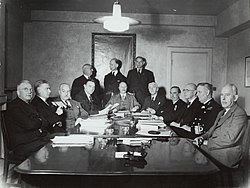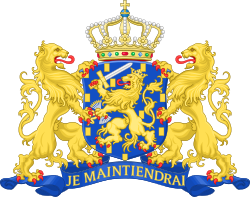Second Gerbrandy cabinet Third London cabinet | |
|---|---|
| Cabinet of the Netherlands | |
 Meeting of the Second Gerbrandy cabinet in late 1944 | |
| Date formed | 27 July 1941 |
| Date dissolved | 23 February 1945 (Demissionary from 21 January 1945) |
| People and organisations | |
| Head of state | Queen Wilhelmina |
| Head of government | Pieter Sjoerds Gerbrandy |
| Deputy head of government | Hendrik van Boeijen (De Facto) |
| No. of ministers | 17 |
| Ministers removed | 6 |
| Total no. of members | 19 |
| Member party | Roman Catholic State Party (RKSP) Social Democratic Workers' Party (SDAP) Anti-Revolutionary Party (ARP) Christian Historical Union (CHU) Free-thinking Democratic League (VDB) Liberal State Party (LSP) |
| Status in legislature | National unity government |
| History | |
| Legislature terms | 1937–1945 |
| Predecessor | First Gerbrandy cabinet |
| Successor | Third Gerbrandy cabinet |
| This article is part of a series on |
| Politics of the Netherlands |
|---|
 |
The Second Gerbrandy cabinet, also called the Third London cabinet was the Dutch government-in-exile from 27 July 1941 until 23 February 1945. The cabinet was formed by the political parties Roman Catholic State Party (RKSP), Social Democratic Workers' Party (SDAP), Anti-Revolutionary Party (ARP), Christian Historical Union (CHU), Free-thinking Democratic League (VDB) and the Liberal State Party (LSP) following the resignation of First Gerbrandy cabinet on 12 June 1941. The national unity government was the third of four war cabinets of the government-in-exile in London during World War II. [1]




















